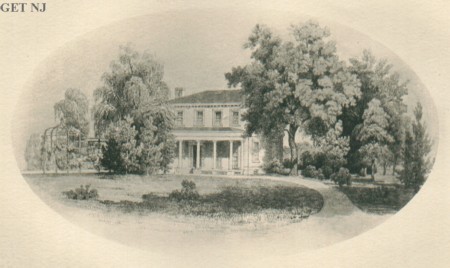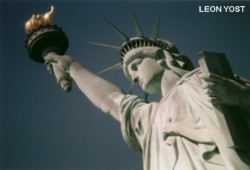BLOOMSBURY the beautiful, as
Bloomsbury Court used to be
called in the days of Colonel
John Cox's ownership, is truly a
house of many memories. In its
colonial garden there still stands
an aged ash-tree, planted by
the wealthy and noted William Trent, the erector of the original Bloomsbury and the
founder of Trenton ; and flanking the building itself are
bushes of aged box, reminiscent of the days of the
Georges. Under the shade of the ash-tree and the boxwood hundreds of roses bloomed in the long ago, fair
white-hearts and gloires de Dijon, loved and tended by
the Demoiselles Chevalier, the French aunts of Mrs.
John Cox.
One is prone to dream as he whispers the stately and
euphonious name of Bloomsbury, for it belongs to the
blossoming Trenton of yesterday, the Trenton of brick
houses and brick-walled gardens an English visitor of
the eighteenth century compared to a Devonshire town.
Its leafy streets and lanes charmed many travellers. Two of the most noted were the gossipy Marquis de
Chastellux and the Duke de la Rochefoucauld. The
latter wrote iii his diary ,that it was a pleasant place,
and numerous handsome villas enriched the landscape
of the environs."
Standing in the summer sunlight before the Bloomsbury of to-day, and shutting one's eyes to the growing
city and her multitudinous voices, what genuine lover
of history cannot obtain glimpses of the panorama of
the past. Through the wide colonial doorway, a portion
of Trent's Bloomsbury, where the great William Penn
was often entertained, many figures pass: gentlemen of
affairs, quiet, sombre-garbed Quakers, and gentlemen of
the army. And who cannot see the ladies! Lovely
visions in brocade and calico, flitting in and out like
shadows.
|
During the Revolution Bloomsbury Court was oc-cupied for a short period by Dr. William Bryant, a
practising physician of great repute, and afterwards by
Colonel John Cox, assistant quartermaster to General
Greene. The Coxes were greatly beloved by the dancing
Greenes, and General Greene made the appointment of
John Cox to serve under him a condition of his acceptance of the position of quartermaster-general.
|
|
Dr. William Bryant was a brother of Mary Bryant, who became
the wife of William Peartree Smith, of Elizabethtown. His father was
a sea-captain, and his tombstone in Perth Amboy records that he made
fifty-five voyages between New York and London. |
|
At the time the war broke out John Cox and his
family were living in a fine dwelling on Third Street,
Philadelphia. He was the owner of an iron foundry at Batisto, New Jersey, from which some of his ample
income was derived. During the war it supplied the
army with a large amount of ordnance. On one occasion it nearly fell a prey to the British invaders, who
passed by it on their way to Philadelphia. Owing to
a skilful arrangement of lumber in covering the guns
and cannon-balls the redcoats mistook it for a lumberyard.
The Batisto foundry played an important part in the
lives of the Cox family; and when the Quaker City was
given over to Lord Howe and his aides, Mrs. Cox and
her daughters fled to a farm-house in its vicinity for safety.
In some old letters of the period, written by the Cox
family to friends, we obtain a glimpse of the hardships
they endured while there and learn to appreciate better
the bravery of the carefully-nurtured patriot women of
the Revolution.
The lovely Mrs. Cox, who has been described as "an
angel of a woman" and a leader of the beau monde of
Trenton and Philadelphia, was then forced to do up her
hair with thorns in lieu of hair-pins, and her six daughters went about in home-made linsey-woolsey. (Mrs. Cox before her marriage was Esther Bowes, the daughter of
Sir Francis Bowes.) Miss
Rachel Cox was seen at Valley Forge by Tory friends,
and rallied by them on her " homespun appearance," but
they later took pity on her forlorn condition, and helped
her to secure some " London trades" for a more fashion-
able wardrobe.
Perhaps it was at Batisto that the Cox family learned
the wise lesson of simplicity of manners and costuming. At a later period, when the fashionables of Trenton and
Philadelphia were rioting in every extreme of foreign
extravagance and luxury, the Cox girls in their muslins
charmed the occupants of all the drawing-rooms they
entered. Bloomsbury Court during the Cox regime
was a republican Hotel de Rambouillent in miniature.
All that was best in the surrounding country came there.
Old Trenton society crowded in its salons for the purpose of conversation. Often there was some air of
Handel and Mozart played or sung by an eighteenth-century celebrity, or the reading of the latest poem
by a well-known litterateur. Mrs. Cox herself had the
volatile essence of gaiety and wit that characterized
the women of the famous French salons, and her six
daughters, – Catherine, Rachel, Sarah, Mary, Esther, and
Elizabeth, – who inherited the quality with the additional fragrance of individuality, made a series of the
most brilliant matches in the annals of old Philadelphia society.
General Washington and his lady enjoyed the hospitality of Bloomsbury Court, and the Marquis de Lafayette, Rochambeau, and other noted Frenchmen were
entertained there. Many of the meals were served in
the garden amid the roses of the Demoiselles Chevalier,
and those stately ladies were always present conversing
with their Gallic visitors in their native language. Sarah
Cox, then a girl in her teens, used to relate in after years
as Mrs. John Redman Coxe, the pleasure she took in
seeing the family plate brought out for these occasions
and the bustle and stir they brought to the family
kitchen. "Those were Bloomsbury days," she used to sigh, and, according to Cox traditions, "Bloomsbury
days" were best.
One of the most welcome visitors at Bloomsbury
Court, Bellville,and other houses in the vicinity was a
young Swedish aide-de-camp to Rochambeau, Count
Jean de Ferson. (Belville was the seat of Sir John Sinclair. It was occupied at dif-
ferent periods of the Revolution by the Stirlings and the Rutherfords.) This fascinating figure in our Revolu-tionary society has been described as a man of the pure
blond type and beauty almost god-like. Marie Antoinette fell under the influence of his charm when he
belonged to the revellers of the French court, and there
is a story told that in disguise they often visited the
streets of Paris together. It is said that his advent in
America was due to his regard for her majesty's reputation, as the preference she showed for his society was
noted in the tittle-tattle of the court. His character as
well as his personality was much admired, and the Cox
ladies were no doubt as sensible of his attractions as the
unfortunate queen of France. Of all the famous men
who walked among the Chevalier roses in the Cox
garden his life was the most brilliantly adventurous, for
he it was who, disguised as a coachman, drove Louis
XVI. and Marie Antoinette from Paris to Varennes on
the occasion of their pitiful attempt to escape from the
throne crumbling and falling about them.
At the time Trenton was being talked over as the
probable capital of the United States many distinguished
visitors were entertained at Bloomsbury Court, and the
list would be a very long one if enumerated. When
General Washington passed through the city on his way to New York in 1789, Mrs. Cox was among the
matrons who received him, and all her daughters took
part in the festivities. The two youngest daughters –
Sarah Cox, who afterwards became the wife of Dr. John
Redman Coxe, and Elizabeth the wife of Horace Binney
– were flower-girls by the famous arch.
The Cox family disposed of Bloomsbury Court some
time before the dawn of the nineteenth century. Among
the families subsequently connected with its ownership
and history are the Dickinsons, Redmans, Hewitts,
Prices, Woods, and, last of all, the Stokes. Mr. James
H. Redman erected the wooden addition while he
occupied it as a residence, but the main house, built
of bricks brought from England as ballast by the
Trent and Penn merchantmen, is still in excellent condition. Its interior is very interesting. The old paper
on the hall walls came from Alsace-Lorraine and is hand-
painted with views of Eldorado scenery. On the walls
of the rooms which listened to the voices of the gay
Frenchmen of the court of Louis XVI., fate has placed
paintings once owned by the Bonapartes. The famous
old garden is still a riot of loveliness in the summer-time.
To-day the old mansion is called Woodland, both fitting
and appropriate. But when one pictures the old Demoi-
selles Chevalier among their roses, his mind reverts to
the more poetic name of Bloomsbury bestowed upon it
by the founder of Trenton.













